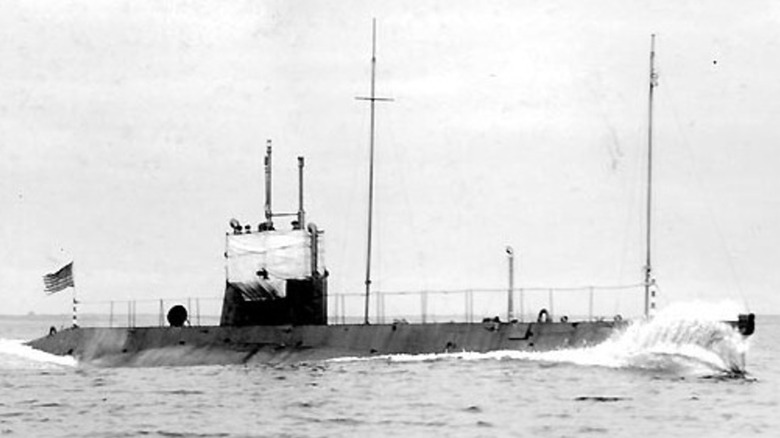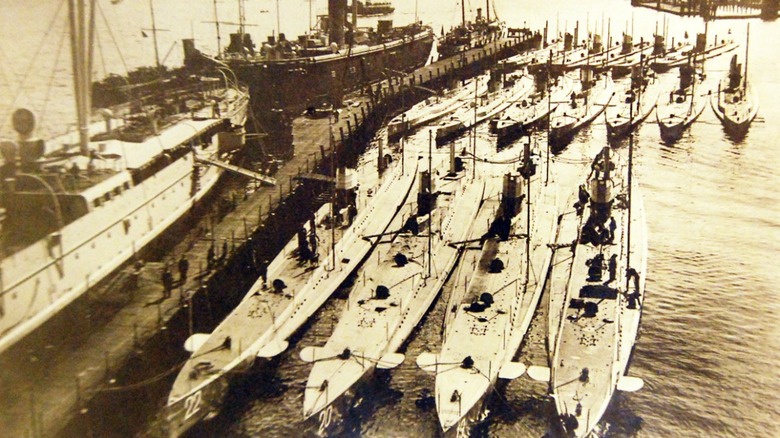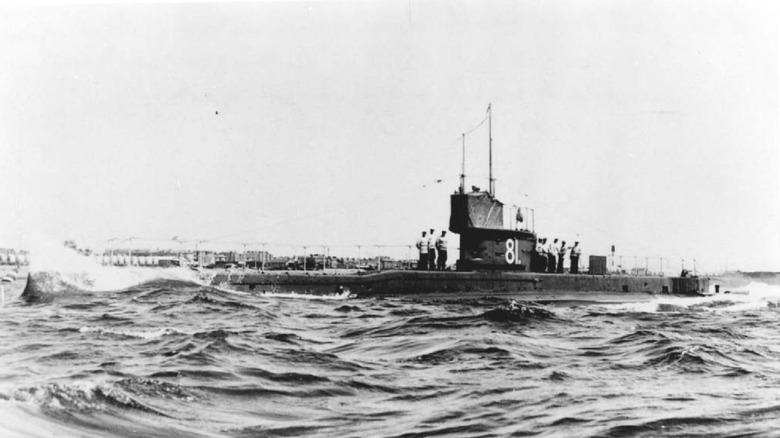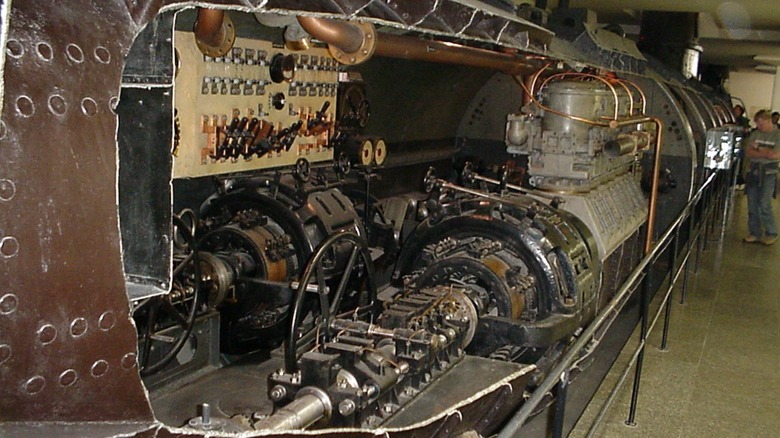WW1 Submarines: What Were They Used For And Do Any Still Exist?
Typically, when people think of submarine warfare, they probably recall the deadly U-boats of World War II. While that conflict saw widespread use of submarines, it was hardly the first to utilize the silent vessels. In fact, the first use of a submarine in combat occurred in 1776 during the War for American Independence. Granted, it was rudimentary and wasn't successful, but it demonstrated the viability of the technology.
There were many submarines navigating the depths before the 1900s, but their first significant impact on a conflict came during World War I. Submarines made up relatively small portions of each combatant's total fleet during WWI, but that didn't make them any less useful or deadly. Initially, nations followed the naval tradition of warning merchant ships and sparing the crew before an attack. Germany changed the tactic during WWI via unrestricted submarine warfare, which meant that German U-boats could attack without warning any vessel it came across.
Germany sank the civilian vessel, RMS Lusitania, in an act of unrestricted submarine warfare, which helped draw the U.S. into the conflict. Still, Germany wasn't the only nation to use submarines during WWI, joining Italy, the U.S., the United Kingdom, and others. When the war began, no nation had a viable strategy for effectively employing submarines in warfare, but that changed as the war raged on. The submarines of WWI impacted the development and use of the boats in WWII, and only a handful remain that people can visit in museums around the world.
The deadly U-boats of WWI
The Imperial German Navy's U-boats were some of the deadliest vessels of the war, and they were responsible for sinking over 5,000 Allied ships. That amounted to around 12 million tons of supplies, costing around 5,000 lives and 178 U-boats. The use of unrestricted submarine warfare made it easier for Germany to take on mercantile vessels supplying the Allies throughout the Atlantic Ocean, and it's not hyperbole to say that the world's navies feared German U-boats.
In 1914, Germany began producing Type U 19 submarines (pictured), which were some of history's most significant military submarines. Boats of this type featured between one and two deck guns and four torpedo tubes. They displaced 837 tons of seawater while submerged and boasted a range of 7,600 miles when cruising at 17.7 mph on the surface. They measured 210 feet in overall length and could travel up to 11 mph while submerged. The U-20, which sank the RMS Lusitania, was of this type.
While the U 19 submarines had plenty of success, they weren't the only type Germany sailed during the conflict. Germany built 329 U-boats of different types, which Imperial Germany and its allies used throughout WWI. More than half were lost to various enemy actions and engagements, and few parts of any U-boats survived the war. Several U-boats were larger, displacing upwards of 1,500 tons of seawater. Some were more powerful than others, while many were smaller and used to lay mines and conduct other operations.
The Allied submarines of WWI
Throughout WWI, the Royal Navy sailed a fleet of 156 submarines, which was significantly smaller than Imperial Germany, but that didn't make them ineffective. France, the U.K., and the U.S. all brought submarines to the fight, each with its own unique abilities. The Royal Navy's most successful was the HMS E11, an E-class submarine with an excellent combat record. That class displaced 788 to 793 tons while submerged, stretched 176 to 181 feet, and could cruise at 17.55 mph while surfaced. It was sold for scrap after the war.
When the United States joined the conflict in 1917, it did so with a modest fleet of submarines of various types. By the end of the conflict, the U.S. had built and used 72, ranging from B-class to N-class. The L-class submarines made up a large portion of the Atlantic fleet, and they served throughout the war. The USS L-1 (SS-40) featured a diesel-electric engine, which made it capable of reaching speeds of 16 mph on the surface. The submarine displaced 548 tons of seawater while submerged, and measured 167.5 feet long.
Other allied nations had submarines, including Australia. The Royal Australian Navy acquired its submarines from the U.K. These were the HMAS AE1 and AE2, Australia's first military submarines. These were manned by British and Australian sailors, and they took part in several campaigns. The AE1 and AE2 were relatively large, measuring 181 feet in length with a displacement of 726 tons of seawater while submerged.
What remains of WWI submarines
The majority of WWI submarines no longer exist, as many were sunk or sold for scrap. This isn't an unusual practice for the world's navies, but some boats remain and can be visited in museums. Often, only a small piece survives, so a museum may have something like a boat's conning tower or deck gun, but nothing else. However, there is one German U-boat that's not only intact, but is also able to be visited. The SM U-1 was built before the war, and Germany decommissioned it before the submarine saw a single battle.
When WWI kicked off, the U-1 was already obsolete, so it was relegated to training only. In 1919, it hit another vessel while on exercise and was decommissioned. Eventually, the submarine found its way to the Deutsches Museum in Munich, Germany, where it remains open to the public. The entire vessel still exists and is an extremely rare example of a surviving WWI submarine. Parts of the starboard hull have been cut away to show the innards.
The U-1 is a historically significant submarine, as it was the first used by the German Imperial Navy. Other museum exhibits include the conning tower from the HMS E50 at Sea War Museum Jutland in Thyborøn, Denmark; the conning tower from the Andrea Provana in Turin, Italy; and Sweden's fully intact HM Hajen (The Shark) is on display at the Naval Museum in Karlskrona, Sweden. There are other smaller exhibits, but these four are the most intact.



